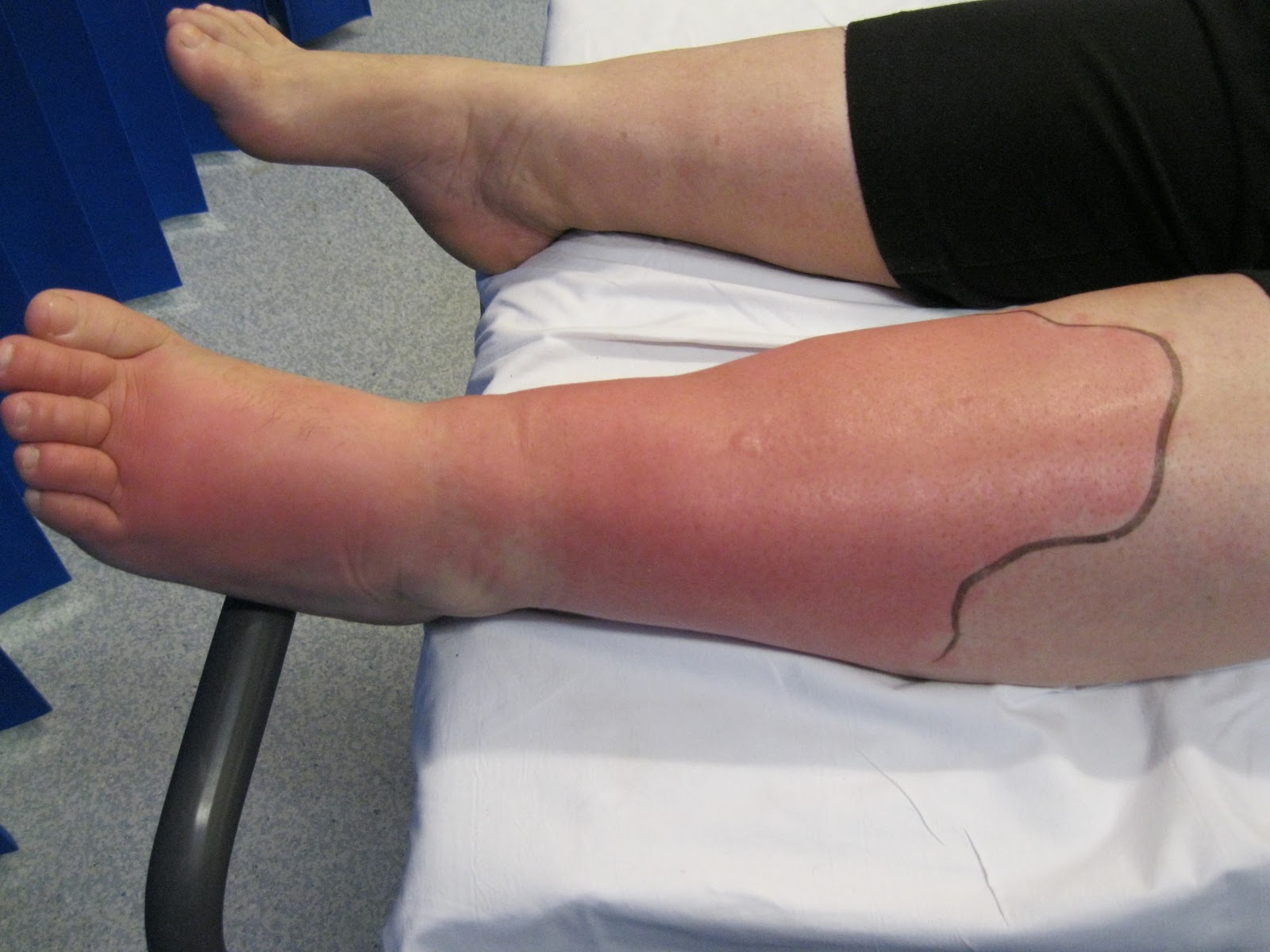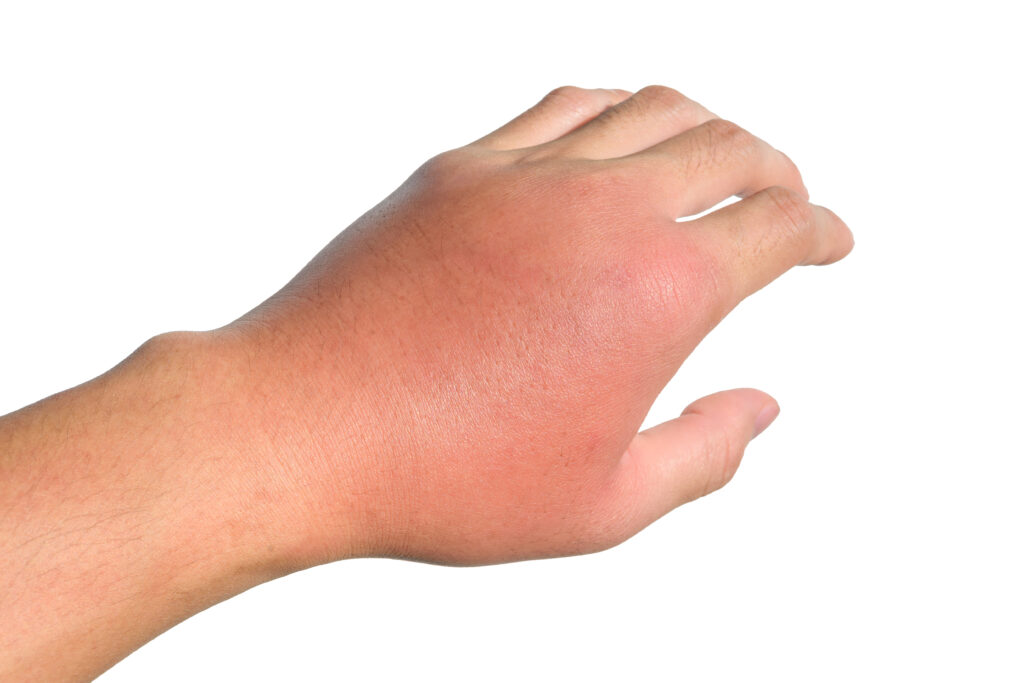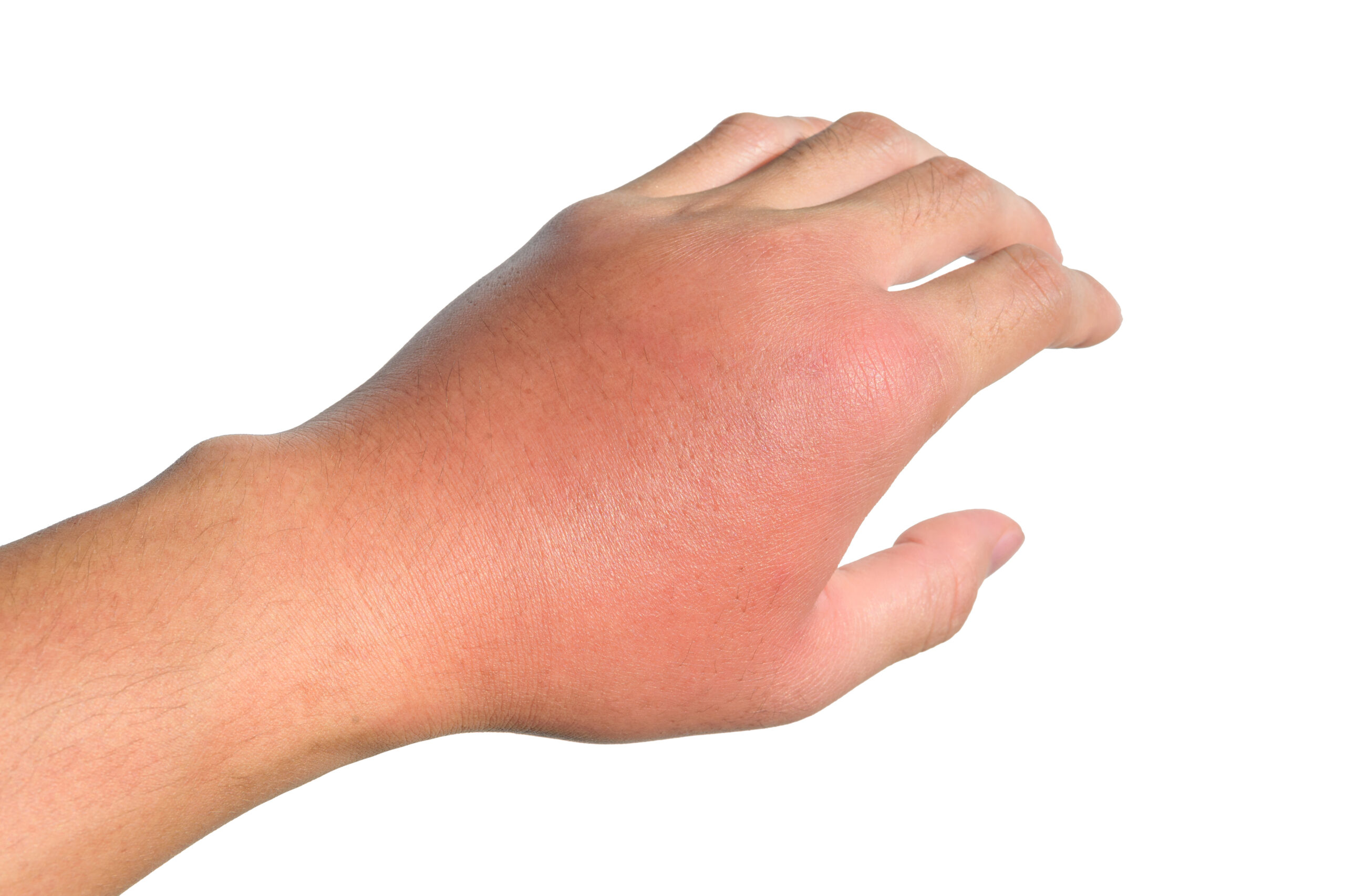Cellulitis is a bacterial skin infection that affects the deeper layers of your skin. It’s generally not contagious and can’t be transmitted from person to person.
Cellulitis develops when bacteria enter through breaks in your skin, often when you have a wound (such as a cut or an animal bite) or when living with lymphedema, a chronic condition that causes swelling.
What Is Cellulitis?
Cellulitis is a bacterial skin infection that affects the deeper layers of your skin and the tissue under it. The infection causes inflammation that makes the affected area red, swollen, warm, and often painful.

Common symptoms of cellulitis include:
- Redness in an area of skin that typically expands
- Swollen skin and tenderness in the affected area
- Skin that feels warm to the touch
- Pain or soreness in the affected area
- Pitted skin, dimpling, or blisters
- Flu-like symptoms, such as fever and chills
- Swollen lymph nodes near the infection
- Fatigue
Cellulitis is a very common bacterial infection, with over 14 million cases in the US each year. It can be effectively treated with antibiotics, but the infection can become serious or even life-threatening if left untreated.
Cellulitis infection can spread rapidly through the body, potentially leading to sepsis (a dangerous bloodstream infection) or damage to the lymphatic system.
If you suspect you have cellulitis, see a doctor immediately or seek emergency care as soon as possible.
What Triggers Cellulitis?
Cellulitis occurs when certain bacteria enter through a crack or break in your skin’s surface.
The most common bacteria involved are Streptococcus and Staphylococcus. A particularly concerning form called methicillin-resistant Staphylococcus aureus (MRSA) is becoming more common and can cause more difficult-to-treat infections.
Anyone can get this bacterial infection. However, certain risk factors make developing cellulitis more likely:
- Skin conditions that cause breaks in the skin (like eczema or athlete’s foot)
- Recent injuries, burns, cuts, animal or human bites, and other skin wounds
- Weakened immune systems due to medications or conditions like diabetes
- Lymphedema, a condition causing swelling due to lymph fluid buildup
- Poor circulation
- Obesity or being overweight
- Previous history of cellulitis infection
Keeping your wounds clean and covered helps lower your risk of developing cellulitis.
Even small breaks in the skin can allow bacteria to enter, so keeping tiny open wounds like insect bites clean is more important than many people think, especially if you have a weak immune system.
When living with lymphedema, regular self-care and good skin hygiene can also prevent cellulitis infection.
Can I Get Cellulitis From Someone Else?
No, cellulitis is not typically considered contagious.
The bacteria that cause cellulitis are common on skin surfaces and in the environment, but they generally only cause infection when they enter through breaks in the skin.
In very rare circumstances, direct contact between your open wound and the infected wound of someone with cellulitis could potentially transfer bacteria. However, this scenario is uncommon and not the typical way cellulitis develops.
Most cases of cellulitis occur when bacteria that are already present on your skin enter through a cut, scrape, or other skin damage. You don’t usually catch cellulitis from another person.
Can Cellulitis Be Caused By Poor Hygiene?
Poor hygiene doesn’t directly cause cellulitis, but it makes the infection more likely. Dirty skin can naturally have more harmful bacteria on it, which increases your risk if you get a cut or scrape.
Basic skin care habits can help you lower your risk of cellulitis:
- Wash your hands often with soap and water, especially before you touch a wound
- Keep your nails clean and trimmed
- Take regular showers and dry your skin well, especially between your toes and in skin folds
- Wear clean clothes
- Clean any cuts or scrapes right away with mild soap and water
- Cover wounds with clean bandages
Overall, proper hygiene is very important, especially if you’re living with skin conditions like eczema, lymphedema, or a weakened immune system.
Is Cellulitis of the Eye Contagious?
Eye cellulitis, like other forms of cellulitis, is not contagious. It doesn’t spread from person to person through casual contact or airborne transmission.
There are two main types of eye cellulitis:
- Periorbital cellulitis (also called preseptal cellulitis) affects the eyelid and surrounding tissue but doesn’t extend into the eye socket itself. This type often affects children.
- Orbital cellulitis affects the tissues within the eye socket (orbit) and is more serious. It can cause pain with eye movement, vision problems, and limited eye mobility.
Both types require prompt medical attention. Treatment typically begins with oral antibiotics, but more severe cases may require intravenous antibiotics or even surgical drainage.
If you notice redness, swelling, or pain around your eye, seek medical care immediately.
What Does the Beginning of Cellulitis Look Like?

Early cellulitis typically appears as a red, swollen, and tender area of skin. In the beginning stages, you might notice a small area of skin that’s getting redder, mild swelling, tenderness, or pain. The infected area might also feel warm to the touch.
The redness often starts small but can spread quickly over hours or days. If you notice a red area that’s expanding, getting more painful, or developing red streaks, these are signs that you should seek medical care right away.
Early cellulitis might be confused with an insect bite, but cellulitis typically doesn’t have the central puncture mark of a bite and tends to spread more rapidly.
How Is Cellulitis Diagnosed?
Doctors typically diagnose cellulitis based on a physical examination of your skin and a review of your symptoms and medical history. During your appointment, your doctor will:
- Examine the affected area, noting its appearance, temperature, and tenderness
- Ask about recent injuries, surgeries, or skin conditions
- Check for fever or other signs of infection
- Look for swollen lymph nodes near the affected area
In most cases, you won’t need to do any special tests to diagnose cellulitis.
However, if your infection is severe or doesn’t respond to initial treatment, your doctor might:
- Take a sample of any drainage from the affected area to identify the specific bacteria causing the infection (bacterial culture)
- Order blood tests to check for signs of infection in your bloodstream
- Request imaging tests like an X-ray, ultrasound, or MRI if there’s concern about a deeper infection
It’s essential to get an accurate diagnosis and treat cellulitis early because it can progress quickly and become serious.
Should I Go to the ER for Cellulitis?
Mild cases of cellulitis can be treated by your primary care doctor with oral antibiotics. However, there are situations when you should go to the emergency room for cellulitis:
- If the red area is spreading rapidly (mark the border with a pen and check if it expands beyond this line)
- If you develop a fever above 100.4°F (38°C)
- If you notice red streaks extending from the infected area toward your heart
- If the pain is severe or getting significantly worse
- If you have facial or eye cellulitis
- If you have symptoms of severe infection, like confusion, rapid heartbeat, or difficulty breathing
- If you have a weakened immune system due to conditions like diabetes, HIV, or cancer treatments
If you’ve been taking antibiotics for cellulitis but see no improvement or if your symptoms worsen despite treatment, you should seek emergency care right away.
When in doubt, it’s better to get checked at the ER than to wait too long.
Cellulitis FAQs
Is Cellulitis Contagious Sexually?
No, cellulitis is not a sexually transmitted infection. It can affect the genital area like any other part of the body, but it doesn’t spread through sexual contact itself. In rare cases, people have developed cellulitis in the genital region after sexual activity, particularly those with compromised immune systems or those who’ve had cancer treatments affecting lymphatic circulation. These cases typically involve an existing wound or break in the skin that allows bacteria to enter. If you or your partner has open wounds in the genital area, consider avoiding sexual activity until healing.
Is Periorbital Cellulitis Contagious?
No, periorbital cellulitis (affecting the eyelid and area around the eye) is not contagious from person to person. Like other forms of cellulitis, it occurs when bacteria enter through a break in the skin or spread from a nearby infection like sinusitis. You can’t catch periorbital cellulitis from being near someone who has it or by touching the affected area.
Is Orbital Cellulitis Contagious?
No, orbital cellulitis (affecting the tissues within the eye socket) is not contagious. This infection develops when bacteria enter the eye socket area, often spreading from sinus infections or after eye injuries. It can’t be transmitted from one person to another through casual contact, sharing items, or being close to each other.
How Long Are You Contagious with Cellulitis?
Cellulitis isn’t contagious, so there is no contagious period. The bacteria that cause cellulitis (typically staph bacteria or strep bacteria) are commonly found on skin or in the environment. Infection develops only when these bacteria enter through a break in the skin, so you can’t spread your cellulitis to others.
Is Cellulitis the Same as Staph?
Cellulitis and staph infections are not the same, but there’s a connection between them. Staphylococcus (staph) is a type of bacteria that can cause many different infections, including cellulitis. Staph bacteria are often responsible for cellulitis, but the infection can also be caused by other bacteria, like Streptococcus. Cellulitis specifically refers to the infection of deeper skin tissues, regardless of which bacteria caused it.
Final Thoughts on Cellulitis: Is It Contagious?
Cellulitis isn’t contagious. It’s a bacterial infection of the skin, and you can’t catch it through casual contact with an infected person. It develops when bacteria enter through breaks in your skin. While cellulitis isn’t contagious, it can be serious and requires proper medical treatment.
The best prevention strategies include good skin hygiene, prompt treatment of skin injuries, and managing conditions that increase your risk, such as lymphedema (chronic swelling).
You can learn more about lowering your risk of cellulitis in Lower Body Lymphedema Rehab and Breast Cancer Rehab.











